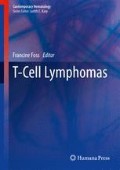Abstract
The extranodal T-cell lymphomas comprise approximately 10 % of aggressive T-cell lymphomas. Defined largely by their tissue trophism, these disorders have generally been associated with a poor outcome after conventional therapeutic approaches. The panniculitis-like T-cell lymphomas may be associated with inflammatory panniculitis or autoimmune disorders and often have an excellent prognosis, while the gamma delta cytotoxic T-cell lymphomas of the skin have a poor outcome. Hepatosplenic T-cell lymphomas are often associated with isochromosome 7q and have been associated with immunosuppressive therapy, while the enteropathy-associated T-cell lymphomas are comprised of two morphologic types, one of which arises in the setting of celiac sprue. Treatments for these rare T-cell lymphomas are not well defined, but newer agents have shown promise.
Access this chapter
Tax calculation will be finalised at checkout
Purchases are for personal use only
References
Swerdlow SH, Campo E, Harris NL, et al. WHO classification of tumours of haematopoietic and lymphoid tissues. 4th ed. Lyon: IARC Press; 2008.
Vose J, Armitage J, Weisenburger D. International peripheral T-cell and natural killer/T-cell lymphoma study: pathology findings and clinical outcomes. J Clin Oncol. 2008;26:4124–30.
Tripodo C, Iannitto E, Florena AM, et al. Gamma-delta T-cell lymphomas. Nat Rev Clin Oncol. 2009;6:707–17.
Farcet JP, Gaulard P, Marolleau JP, et al. Hepatosplenic T-cell lymphoma: sinusal/sinusoidal localization of malignant cells expressing the T-cell receptor gamma delta. Blood. 1990;75:2213–9.
Roschewski M, Wilson WH. Biology and management of rare primary extranodal T-cell lymphomas. Oncology (Williston Park). 2010;24:94–100.
Schmidt LA, Lim MS. T cell lymphoproliferative disorders associated with anti-tumor necrosis factor alpha antibody therapy for ulcerative colitis: literature summary. J Hematop. 2009;2:121–6.
Kotlyar DS, Osterman MT, Diamond RH, et al. A systematic review of factors that contribute to hepatosplenic T-cell lymphoma in patients with inflammatory bowel disease. Clin Gastroenterol Hepatol. 2011;9(1):36–41. e1.
Weidmann E. Hepatosplenic T cell lymphoma. A review on 45 cases since the first report describing the disease as a distinct lymphoma entity in 1990. Leukemia. 2000;14:991–7 (08876924).
Miyazaki K, Yamaguchi M, Imai H, et al. Gene expression profiling of peripheral T-cell lymphoma including gammadelta T-cell lymphoma. Blood. 2009;113:1071–4.
Bennett M, Matutes E, Gaulard P. Hepatosplenic T cell lymphoma responsive to 2’-deoxycoformycin therapy. Am J Hematol. 2010;85:727–9.
Schafer E, Chen A, Arceci RJ. Sustained first remission in an adolescent with hepatosplenic T-cell lymphoma treated with T-cell leukemia induction, nucleoside analog-based consolidation, and early hematopoietic stem cell transplant. Pediatr Blood Cancer. 2009;53:1127–9.
Falchook GS, Champlin R, Hagemeister FB, et al. Hepatosplenic T-cell lymphoma: clinical characteristics and treatment outcome. ASH Annual Meeting Abstracts 2006;108:2460.
Falchook GS, Vega F, Dang NH, et al. Hepatosplenic gamma-delta T-cell lymphoma: clinicopathological features and treatment. Ann Oncol. 2009;20:1080–5.
Willemze R, Jansen PM, Cerroni L, et al. Subcutaneous panniculitis-like T-cell lymphoma: definition, classification, and prognostic factors: an EORTC Cutaneous Lymphoma Group Study of 83 cases. Blood. 2008;111:838–45.
Go RS, Wester SM. Immunophenotypic and molecular features, clinical outcomes, treatments, and prognostic factors associated with subcutaneous panniculitis-like T-cell lymphoma: a systematic analysis of 156 patients reported in the literature. Cancer. 2004;101:1404–13.
Salhany KE, Macon WR, Choi JK, et al. Subcutaneous panniculitis-like T-cell lymphoma: clinicopathologic, immunophenotypic, and genotypic analysis of alpha/beta and gamma/delta subtypes. Am J Surg Pathol. 1998;22:881–93.
Kong YY, Dai B, Kong JC, et al. Subcutaneous panniculitis-like T-cell lymphoma: a clinicopathologic, immunophenotypic, and molecular study of 22 Asian cases according to WHO-EORTC classification. Am J Surg Pathol. 2008;32:1495–502.
Alpdogan O, Ornstein D, Subtil T, et al. Outcomes in subcutaneous panniculitis-like T-cell lymphoma (STCL). Blood (ASH Annual Meeting Abstracts) 2008;112:3750.
Rojnuckarin P, Nakorn TN, Assanasen T, et al. Cyclosporin in subcutaneous panniculitis-like T-cell lymphoma. Leuk Lymphoma. 2007;48:560–3.
Chim CS, Loong F, Ng WK, et al. Use of fludarabine-containing chemotherapeutic, regimen results in durable complete remission of subcutaneous panniculitis-like T-cell lymphoma. Am J Clin Dermatol. 2008;9:396–8.
Jantunen E, Relander T, Lauritzsen GF, et al. Intensive induction chemotherapy followed by autologous stem cell transplantation (ASCT) In: Patients with enteropathy-associated T-cell lymphoma: a prospective study by the nordic lymphoma group (NLG-T-01). Blood (ASH Annual Meeting Abstracts) 116:3565.
Magro C, Segal J, Crowson A, Chadwick P. The phenotypic profile of dermatomyositis and lupus erythematosus: a comparative analysis. J Cutan Pathol. 2010;37(6):659–71.
Author information
Authors and Affiliations
Corresponding author
Editor information
Editors and Affiliations
Copyright information
© 2013 Springer Science+Business Media New York
About this chapter
Cite this chapter
Lansigan, F., Hudnall, S.D., Foss, F. (2013). Rare Subtypes of Extranodal T-Cell Lymphoma. In: Foss, F. (eds) T-Cell Lymphomas. Contemporary Hematology. Humana Press, Totowa, NJ. https://doi.org/10.1007/978-1-62703-170-7_7
Download citation
DOI: https://doi.org/10.1007/978-1-62703-170-7_7
Published:
Publisher Name: Humana Press, Totowa, NJ
Print ISBN: 978-1-62703-169-1
Online ISBN: 978-1-62703-170-7
eBook Packages: MedicineMedicine (R0)

